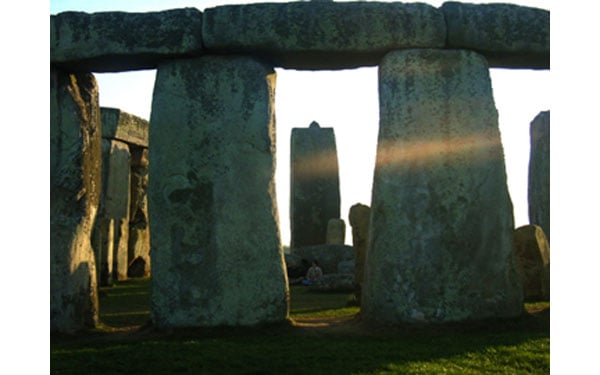Solving the enigma of Stonehenge - Part 2
(Read Part 1)Unbeknownst to many historians, antiquarians and archaeologists searching for solutions to Stonehenge’s mysteries, the centre star of Orion’s three belt stars is Alnilam. That star is located at a declination of -01 o 12’ 06.9”, meaning it is about one degree south of the celestial equator. The celestial equator is simply the earth’s equator projected out to the cosmic sphere surrounding Earth.
The celestial equator can be envisioned as an unseen circle rotating around Earth once every 24r hours. Every star in the sky appears to rotate around Earth once every 24 hours. Astronomers identify the location of each star relative to the position of the vernal equinox, which happens to be the centre of the Northern Cross. Looking at that location in the sky, Alnilam is to the right of the vernal equinox; it has a right ascension of 5 h 36 m 12.8 s. In other words if the length of the celestial equator measured in time is 24 hours, Alnilam is 5 hours, 36 minutes, 12.8 seconds to the right of the centre of the Northern Cross.
Here is where this gets really interesting. The brightest star in Taurus is Aldebaran. Its location is declination +16 o 30’ 33.49”, right ascension 4 h 35 m 55.24 s. Meanwhile, Sirius – the brightest star in the sky – is located at -16 o 42’ 58.15 ”, right ascension 6 h 45 m 8.92 s. Studying the numbers we find that the declination of Alnilam is only -0 o 12’ 24.26”, right ascension 0h 10m 30.72s from the centre point between Sirius and Aldebaran. In fact from the standpoint of naked eye astronomy Alnilam is at that centerpoint!
If the astronomy is causing you more confusion, here is the connection to Stonehenge. During the summer of 2013 I analyzed the spatial relationships of Neolithic monuments constructed within about 2 miles (3.3 km) of Stonehenge. In doing so it was found that scaled positions of the part of the night sky including the Northern Cross, Orion, Auriga, Taurus and Sirius plot such that long barrow Amesbury 42, the Heelstone at Stonehenge, the centre of Woodhenge, Coneybury Henge and the west end of the Greater Cursus match the map of stars. Plainly, the landscape of monuments constructed 1000 years before megaliths were placed at Stonehenge represents a map of the cosmic area where the spirit of each life comes from, and returns to.
But what of Stonehenge itself? There are four specific locations at Stonehenge each of which was the site of a megalith when the circles of stones were placed in about 2480 BC. The four stones are called the Station Stones. They formed the corners of a near-rectangular area surrounding the central portion of the monument. The Station Stones are numbered 91 through 94. Stone 91 is opposite of stone 92, and stone 92 is opposite of stone 94.

(Paul D. Burley copyright 2012)
Again, results of analysis conducted in 2013 shows that the Station Stone quadrilateral represents the portion of night sky between Aldebaran and Sirius. Stone 92 represents Aldebaran, and stone 94 represents Sirius. Where does Alnilam, centre star of Orion’s belt plot? At the centre of the monument. Emplacing Orion upon Earth at Stonehenge, the symbolism is clear. The monument represents the cosmos and Earth brought together to create life in spirit and body.
The surrounding landscape represents the source and place of return of the spirit. Just as the body upon death is returned to Earth, the spirit is released to return to the stars. The cycle of birth, life, death and re-birth continues without end, conforming to creation, destruction and re-creation of the universe itself.
In the end, what is peculiar about Stonehenge is not its architecture nor its purpose, but our inability until now to recognize what it represented for the people of Britain 4500 and more years ago. It is part of the cycle of life.
--------------------------------------
Paul D. Burley is the author of ‘Stonehenge: As Above, So Below’, published March 2014 by New Generation Publishing, London.
Featured image: Stonehenge. Photo source: April Holloway
By Paul Burley




















Comments
Interesting correlation. Obviously one can never know why they built it without talking directly to the architect(s) who designed it. Analysis such as this gives greater insight, but without an understanding of the beliefs of the culture that built it we can only make educated guesses. Readers might be interested to know astronomer Fred Hoyle published a detailed analysis of the site in 1971 titled: From Stonehenge to Modern Cosmology. The book has beautiful fold-out plot of the henge, and details the three stages of its construction.
Paul
You provided some great info about Stonehenge re Orion and our sky.
I think you have a new and important series of thoughts on this topic.
BUT,
I nearly quit reading early in Part 1.
I felt you threw in too many personal feelings about parts of this
that clouded the good points and diagrams you presented.
I don't mind your personal thoughts as they are important
but they should have been at the end or at the end of a
paragraph.
Sorry, but, since I took time to comment about this
indicates that I felt you had some immense to say
and I couldn't quite grasp it.
Thanks for a fascinating perspective on an age-old mystery.
Have you researched the astronomical orientation of the stone circle at Sacsayhuaman in Peru? During a visit there some years ago we were told the circle had in ages past been filled with water to reflect the starry night sky. It is quite moving to contemplate a ceremony forging such a visible connection between the heavens and the earth, but astronomical context would be helpful.